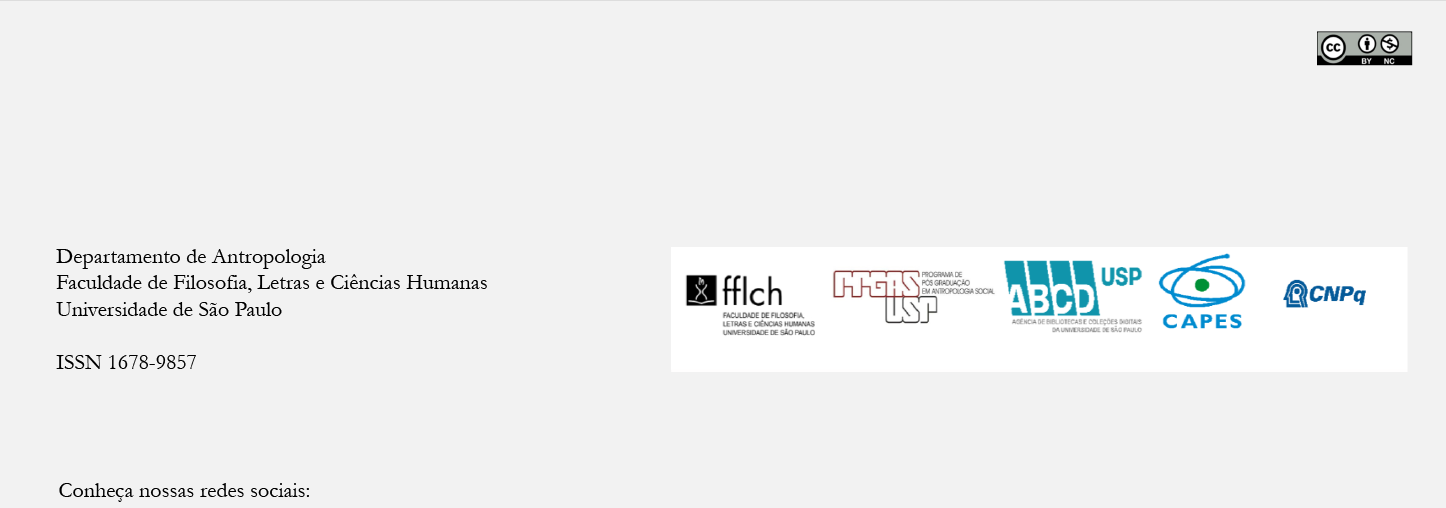Making visible the unspeakable: Capulanas in Northern Mozambique
DOI:
https://doi.org/10.11606/1678-9857.ra.2022.188052Keywords:
Anthropology of art, Attachment, Objects, Wax print fabrics, MozambiqueAbstract
This article presents a theoretical reflection on capulanas (wax print fabrics) in the northern region of Mozambique. It is based on fieldwork conducted in Nampula and Ilha de Moçambique in 2015 and 2017. Beginning with a dialogue with the theoretical propositions of Alfred Gell and Bruno Latour, it suggests that “making capulanas” is not restricted to production. Instead, it happens mainly through circulation and its multiple forms of use. In addition, it addresses what capulanas are “made to do” (faire-faire) and especially what they “make not do” (faire ne pas faire). By covering the bodies and transmitting messages about sensitive matters such as illness, death, and menstruation, they harbor the spheres of the invisible and the unspeakable, and thus they “keep secrets.”
Downloads
References
ARNFRED, Signe e MENESES, Maria Paula. 2019. “Mozambican capulanas: tracing histories and memories”. In KAHN, Sheila; MENESES, Maria Paula; BERTELSEN, Bjorn (org.) Mozambique on the move: challenges and reflections. Leiden/Boston: Brill, pp.189-213.
BARCELOS NETO, Aristóteles. 2008. Apapaatai – rituais de máscaras no Alo Xingu. São Paulo: Edusp.
BECK, Rose Marie. 2000. “Aesthetics of Communication: texts on textiles (Leso) from the East African Coast (Swahili)”. Research in African Literatures 31 (4): 104– 124.
FAUSTO, Carlos. 2013. "A máscara do animista: quimeras e bonecas russas na América indígena", in SEVERI, Carlos; LAGROU, Els (orgs). Quimeras em diálogo: grafismo e figuração nas artes indígenas. Rio de Janeiro: 7Letras, 2013.
GELL, Alfred. 1996. “Vogel's Net: Traps as Artworks and Artworks as Traps”. Journal of Material Culture, vol.1, n.1.
GELL, Alfred. 1998. Art and agency: an anthropological theory. Oxford: Oxford University Press.
GELL, Alfred. 2018. Arte e agência. São Paulo: Ubu Editora.
INGOLD, Tim. 2011. Being alive: essays on movement, knowledge and description. New York: Routledge.
KOHN, Eduardo. 2013. How Forests Think: Towards and Anthropology Beyond the Human. Berkeley: University of California Press.
LAGROU, Els. 2007. A fluidez da forma: artes, alteridade e agência em uma sociedade amazôniza [Kaxinawa, Acre]. Rio de Janeiro: Topbooks.
LAGROU, Els. 2010. “Arte ou artefato? Agência e significado nas artes indígenas”. Proa – Revista de Antropologia e Arte. Ano 02, vol.1, n.2.
LAGROU, Els. 2017. "A figuração do invisível: o encontro de Warburg com as artes ameríndias. O que dele podemos aprender hoje para a antropologia da arte?". In: BICALHO, Poliene e MACHADO, Marcia (org.). Artes indígenas no cerrado: saberes, educação e museus. Goiânia: Ed. da PUC-GO.
LATOUR, Bruno. 1998. “Factures/fractures: de la notion de réseau à celle d’attachement”. Disponível em http://bruno-latour.fr/sites/default/files/76-FAKTURA-FR.pdf.
LATOUR, Bruno. 2012. Reagregando o Social. Bauru, SP: EDUSC/ Salvador, BA: EDUFBA.
LATOUR, Bruno. 2015. "Faturas/Fraturas: da noção de rede à noção de vínculo". Ilha Revista de Antropologia. Florianópolis, v.17, n.2. pp.123-146.
MATTOS, Regiane Augusto. 2018. "Entre suaílis e macuas, mujojos e muzungos: o norte de Moçambique como complexo de interconexões". Estudos Ibero-Americanos. Porto Alegre, v. 44, n. 3, p. 457-469.
MENESES, Maria Paula G. 2003. “As Capulanas em Moçambique: decodificando mensagens, procurando sentidos nos tecidos”. In: Garcia, Regina Leite (org.) Método. Métodos. Contramétodos. SP: Cortez Editora.
SEVERI, Carlo. 2007. Le príncipe da chimère. Une anthropologie da mémoire. Paris: Musée du quai Branly, Aesthetica, Éditions rue d’Ulm.
TORCATO, Maria de Lourdes; ROLLETTA, Paola. 2011. Capulanas e Lenços. 3ª ed. Maputo: Missanga Ideias e Projectos.
YAHYA-OTHMAN, Saida. 1997. “If the Cap Fits: Kanga names and women’s voice in Swahili society”. Afrikanistische Arbeitspapiere: Schriftenreihe des Kölner Instituts für Afrikanistik, n. 51, p.135–149.
Downloads
Published
Issue
Section
License
Copyright (c) 2023 Revista de Antropologia

This work is licensed under a Creative Commons Attribution 4.0 International License.
Authors who intend to publish in this journal must agree with the following terms:
- a) Authors retain copyright and grant the journal the right of first publication. The work is simultaneously licensed under the Creative Commons Attribution License, which allows the work to be shared as long as the author and the initial publication in this journal are appropriately credited.
- b) Authors are authorized to sign additional contracts for non-exclusive distribution of the version of the work published in this journal (e.g., to publish it as a book chapter), as long as the author and the initial publication in this journal are appropriately credited.
- c) Authors are allowed and encouraged to publish and distribute their work online (e.g. on their personal webpage) after the editorial process, for this can generate productive changes as well as increase the impact and citation of the work. See The Effect of Open Access Publications.



